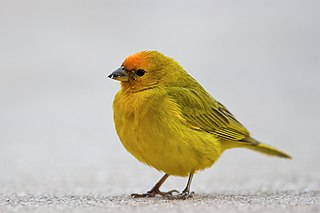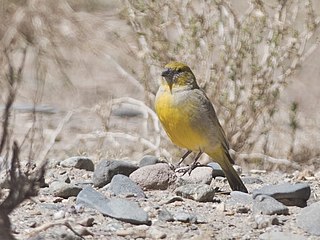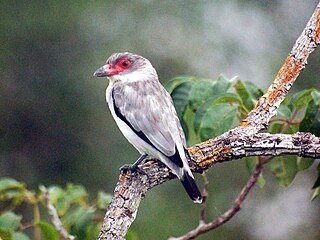
The Accipitriformes are an order of birds that includes most of the diurnal birds of prey – including hawks, eagles, vultures, and kites, but not falcons.

The tanagers comprise the bird family Thraupidae, in the order Passeriformes. The family has a Neotropical distribution. The Thraupidae are the second-largest family of birds and represent about 4% of all avian species and 12% of the Neotropical birds.

The laughing gull is a medium-sized gull of North and South America. Named for its laugh-like call, it is an opportunistic omnivore and scavenger. It breeds in large colonies mostly along the Atlantic coast of North America, the Caribbean, and northern South America. The two subspecies are: L. a. megalopterus – which can be seen from southeast Canada down to Central America, and L. a. atricilla which appears from the West Indies to the Venezuelan islands. The laughing gull was long placed in the genus Larus until its present placement in Leucophaeus, which follows the American Ornithologists' Union.

Caracaras are birds of prey in the family Falconidae. They are traditionally placed in subfamily Polyborinae with the forest falcons, but are sometimes considered to constitute their own subfamily, Caracarinae, or classified as members of the true falcon subfamily, Falconinae. Caracaras are principally birds of South and Central America, just reaching the southern United States.

The grassland yellow finch is a small passerine bird. Despite its name, it is not a finch, but is a seedeater. These were formerly united with the buntings and American sparrows in the Emberizidae, but are now known to be tanagers.

The saffron finch is a tanager from South America that is common in open and semi-open areas in lowlands outside the Amazon Basin. They have a wide distribution in Colombia, northern Venezuela, western Ecuador, western Peru, eastern and southern Brazil, Bolivia, Paraguay, Uruguay, northern Argentina, and Trinidad and Tobago. It has also been introduced to Hawaii, Puerto Rico and elsewhere. Although commonly regarded as a canary, it is not related to the Atlantic canary. Formerly, it was placed in the Emberizidae but it is close to the seedeaters.

The Andean tinamou is a tinamou, found commonly in high-altitude shrubland, in the Andes of South America.
The Marquesan monarch is a species of bird in the family Monarchidae. It is endemic to French Polynesia. Its natural habitats are subtropical or tropical dry forest, subtropical or tropical moist lowland forest, and subtropical or tropical moist montane forest. It is threatened by habitat loss.

The greater yellow finch is a species of bird in the family Thraupidae. It is found in Argentina and Chile. Its natural habitats are subtropical or tropical high-altitude shrubland, temperate grassland, and heavily degraded former forest.

The stripe-tailed yellow finch is a species of bird in the family Thraupidae. It is found in Argentina, Bolivia, Brazil, Colombia, Guyana, Paraguay, Peru, Suriname, and Venezuela. Its natural habitats are dry savanna and pastureland.

The orange-fronted yellow finch is a species of South American bird in the family Thraupidae. It has a highly disjunct distribution with S. c. columbiana found in Colombia and Venezuela, S. c. goeldii along the Amazon River in Brazil, and S. c. goeldii in east-central Brazil. It is found in semi-open areas, typically near water and sometimes near humans. The male closely resembles the saffron finch, but it is smaller, has a more contrasting orange front, and dusky lores. The female is overall olive-gray with whitish underparts, and yellow to the wings and tail.

The Patagonian yellow finch is a species of bird in the family Thraupidae. It is found in Argentina and Tierra del Fuego; also Chile. Its natural habitats are subtropical or tropical dry shrubland and temperate grassland.

The puna yellow finch is a species of bird in the family Thraupidae. It is found in Argentina, Bolivia, and Peru. Its natural habitat is subtropical or tropical high-altitude grassland.

The greenish yellow finch is a species of bird in the family Thraupidae. It is found in the central Andes of Argentina, Bolivia, Chile and Peru. Its natural habitats are subtropical or tropical high-altitude shrubland and heavily degraded former forest.

Raimondi's yellow finch is a species of bird in the family Thraupidae. It is endemic to coastal Peru. Its natural habitats are subtropical or tropical dry shrubland and subtropical or tropical high-altitude shrubland.

The bright-rumped yellow finch is a species of bird in the family Thraupidae. It is found in the Puna grassland : Peru, Bolivia and northern Chile and Argentina. Its natural habitats are subtropical or tropical high-altitude grassland and heavily degraded former forest.

The masked tityra is a medium-sized passerine bird. It has traditionally been placed in the cotinga or the tyrant flycatcher family, but evidence strongly suggests that it is better placed in Tityridae, where it is now placed by the South American Classification Committee.

The chestnut-tipped toucanet is a South American species of bird in the family Ramphastidae. It occurs in humid highland forests along the east Andean slope from southernmost Colombia to central Bolivia. It was formerly considered conspecific with Whitely's toucanet.

Nothoprocta is a genus of birds belonging to the tinamou family Tinamidae. They inhabit scrubland, grassland and open woodland in western South America, particularly in the Andes. They are poor fliers and spend most of their time on the ground. Their diet includes seeds and insects. They nest on the ground, laying large glossy eggs. The eggs are covered with feathers when a potential predator is nearby.

The tepui toucanet or Whitely's toucanet is a South American species of bird in the family Ramphastidae. It is native to the humid forests of the tepuis and other highlands of the Guiana Shield. It was formerly considered conspecific with the chestnut-tipped toucanet.





















